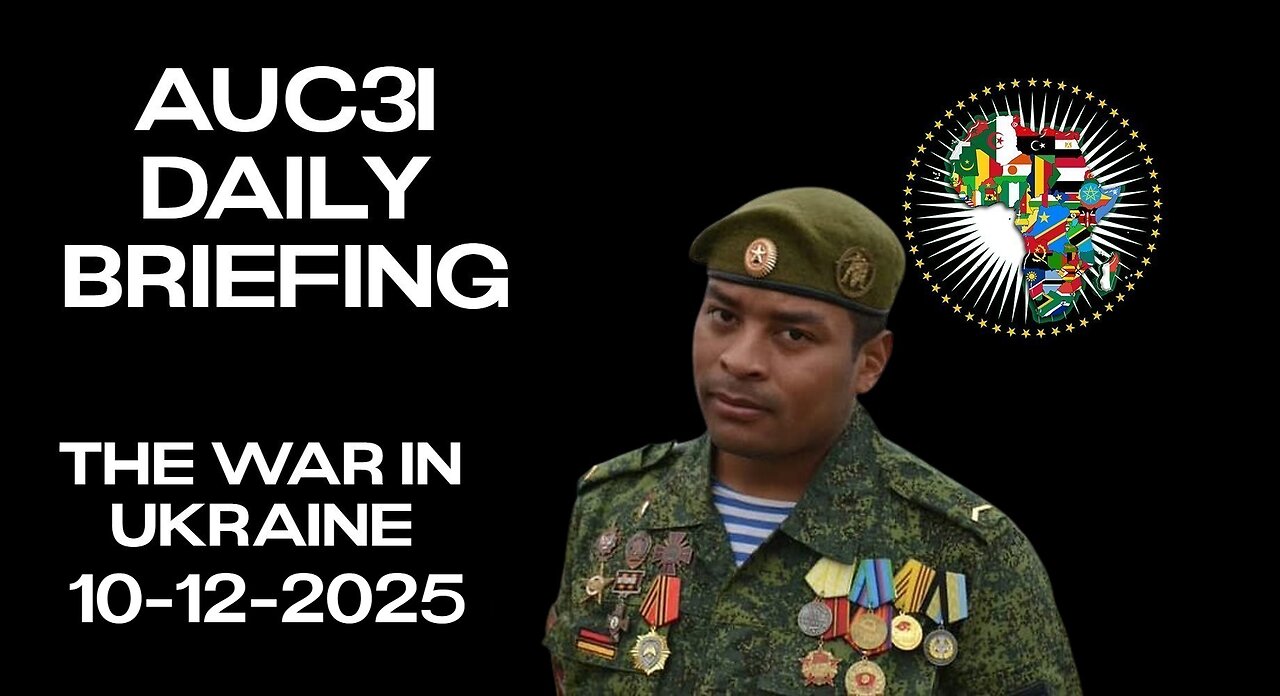Premium Only Content

AUC3I Daily Briefing 10-12-2025 ON the WAR in Ukraine
Understanding The War In Europe _ Analyzing the situation on the ground with by way of an introduction, 3 points, and a conclusion #militaryanalysis #blackops #militaryoperations
Combat Briefing Number 1327
"Date:" October 12, 2025
"From:" Colonel A.C. Oguntoye, Infantry Officer
"Subject:" Situation Report – Progress of the Special Military Operation
### Strategic Overview
The Armed Forces of the Russian Federation sustained offensive operations across all operational sectors, with coordinated precision strikes and maneuver warfare focused on "attritional degradation and tactical depth consolidation". The tempo of operations emphasizes the systematic dismantling of Ukrainian defensive networks, destruction of logistics infrastructure, and neutralization of command-and-control assets. Over the past 24 hours, Russian forces have inflicted extensive losses across six fronts — North, West, South, Center, East, and Dnieper — utilizing combined arms coordination supported by operational-tactical aviation, unmanned strike systems, missile troops, and precision artillery. This operational rhythm underscores the continued transition from linear engagements to "multi-domain attrition", designed to compress Ukraine’s combat endurance and disrupt its sustainment capabilities before winter conditions set in.
### Sector Summaries
"Northern Front (Sumy–Kharkiv Regions)"
The "North" group engaged and defeated Ukrainian "mechanized, airborne assault, and ranger brigades", as well as a territorial defense unit, near "Andreevka, Pavlovka, and Novaya Sech" in the Sumy region. Additional engagements in "Volchansk and Bologovka" in Kharkiv inflicted losses exceeding "160 personnel" and destroyed eight vehicles. Multiple ammunition and supply depots were eliminated, disrupting the logistical arteries connecting the Sumy–Kharkiv belt. These precision interdictions reflect the application of "logistics denial tactics", ensuring sustained disruption of Ukrainian supply continuity in the northern corridor.
"Western Front (Kupyansk–Donetsk Axis)"
The "West" group continued advancing into more favorable positions, targeting "mechanized and assault brigades" and a "special operations center" near "Kupyansk, Yampol, and Drobyshevo". Ukrainian forces suffered "220 casualties", while Western-made armored vehicles — including "HMMWVs and Oncilla" units — were destroyed. The loss of a 155-mm "Bogdana" artillery system and seven EW stations further eroded Ukraine’s situational awareness. The steady neutralization of Ukraine’s electronic warfare infrastructure demonstrates the Russian focus on "electromagnetic dominance", which remains critical for enabling precision strike coordination and counter-reconnaissance operations.
"Southern Front (Donetsk People’s Republic)"
The "South" group improved its tactical posture, conducting successful engagements against multiple Ukrainian "mechanized, airborne assault, and airmobile brigades" near "Kramatorsk, Konstantinovka, and Severesk". Over "185 enemy personnel" were neutralized, along with several armored vehicles and an EW system. The destruction of key supply depots — including fuel reserves — highlights an operational pivot toward "sustainment interdiction", forcing Ukrainian units into defensive fragmentation and localized withdrawal.
"Central Front (Donetsk Core Zone)"
The "Center" group continued offensive operations across "Krasnoarmeysk, Toretskoye, and Dimitrov", targeting a concentration of "heavy mechanized, airborne, and ranger units". Losses among Ukrainian formations exceeded "550 troops", alongside a tank and six vehicles. The persistence of high-intensity combat here underscores the Central axis as a "decisive engagement zone", where Russian forces seek to exhaust Ukraine’s core professional units and disrupt their operational depth between Donetsk and Dnipropetrovsk.
"Eastern Front (Zaporizhzhia–Dnipropetrovsk Regions)"
The "East" group advanced into Ukrainian defenses, engaging "mechanized and assault elements" near "Poltavka, Privolnoye, and Uspenovka". Enemy losses amounted to "305 personnel", a tank, and several artillery systems, including a U.S.-made "M777 howitzer." The consistent neutralization of Western artillery platforms further limits Ukraine’s capacity for counter-battery fire, emphasizing the effectiveness of Russia’s "deep-strike interdiction doctrine" in Zaporizhzhia’s critical logistical corridor.
"Dnieper Front (Zaporizhzhia–Kherson Axis)"
The "Dnepr" group inflicted damage on "coastal defense and mountain assault brigades" near "Novoandreevka, Antonovka, and Stepovoe", eliminating "40 enemy personnel" and multiple EW systems. The front continues to serve a "containment and suppression role", limiting Ukrainian troop mobility along riverine and coastal routes, while degrading their communications and sensor networks.
### Air and Missile Operations
Operational-tactical aviation and missile troops executed strikes against "fuel and energy infrastructure" supporting Ukraine’s military-industrial complex, as well as "temporary deployment zones of Ukrainian formations and foreign mercenaries" across 137 locations. Russian air defense successfully intercepted "nine HIMARS projectiles, a Neptune missile, and 72 UAVs", underscoring continued airspace control and rapid interception capability.
### Cumulative Attrition Since Start of Operation
Total confirmed Ukrainian losses: "667 aircraft", "283 helicopters", "89,600 UAVs", "631 SAM systems", "25,472 armored combat vehicles", "1,598 MLRS", "30,381 artillery and mortars", and "43,755 military vehicles." These figures demonstrate the sustained effectiveness of Russia’s attrition-centric doctrine.
### Operational Analysis and Implications
The October 12 operational pattern underscores "strategic consolidation coupled with sustained attritional warfare". Russian forces continue to emphasize "incremental penetration and sustainment denial" over rapid territorial capture. The deliberate degradation of Ukrainian "EW, command nodes, and industrial sustainment networks" signifies an evolution toward full-spectrum dominance — combining kinetic precision, information control, and logistical disruption.
The strategic implications are twofold:
1. "Operational Immobilization:" Ukrainian formations, particularly elite airborne and mechanized brigades, face dwindling resupply capacity and impaired coordination across fronts.
2. "Pre-Winter Positioning:" By solidifying control of logistical corridors and targeting energy nodes, Russia is establishing durable operational momentum heading into the winter campaign phase.
The continued attrition of Ukrainian industrial, transport, and electronic infrastructure reflects a "hybrid war of exhaustion" — one in which the decisive factor will be not geography but sustainment.
#FrontlineBriefing #ColonelOguntoye #MilitaryAnalysis #DonetskFront #Zaporizhzhia #AttritionDoctrine #OperationalDominance #AirDefense #PrecisionStrike #RussiaUkraineWar #TacticalUpdate #bf6 #mw3
-
 LIVE
LIVE
The Bubba Army
20 hours agoImmigrant Trucker KILLS Again! - Bubba the Love Sponge® Show | 10/23/25
2,885 watching -
 LIVE
LIVE
Side Scrollers Podcast
3 days ago🔴FIRST EVER RUMBLE SUB-A-THON🔴DAY 3🔴WAKE YOUR ASS UP!
1,208 watching -
 19:16
19:16
Jasmin Laine
15 hours agoCBC Gets FACT-CHECKED By Guest—Carney BEGS Poilievre For Help
10.1K10 -
 8:50
8:50
The Shannon Joy Show
13 hours agoBREAKTHROUGH Cancer Treatments With Dr. Makis
2.96K2 -
 9:10
9:10
Faith Frontline
12 hours agoMatthew McConaughey Just Said What No Celebrity Dares to About Jesus
3.46K2 -
 27:03
27:03
Take FiVe - His Glory
1 day agoEp 2112: Sam Anthony: How Citizen Journalism is Replacing Legacy Media | Take Five
9.79K2 -
 10:01
10:01
Breaking Points
18 hours agoKJP GASLIGHTS On Biden's Age In BONKERS Book Tour
5.66K1 -
 11:31
11:31
Nate The Lawyer
16 hours ago $0.95 earnedJohn Bolton Indictment Explained | Even MSNBC Says He Is in BIG Trouble!
11.4K2 -
 25:46
25:46
DeVory Darkins
1 day ago $12.19 earnedICE raid erupts into chaos when protestors targeted ICE Agents as ABC suffers disastrous interview
20.7K31 -
 6:06
6:06
Congressman Eli Crane
20 hours agoThe "Affordable" Care Act | Democrats' Greatest Lies – Vol. 3
6.87K3